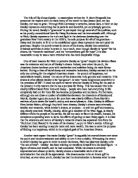Characters:
- Tom Buchanan represents ‘old wealth’, “even in college his freedom with money was a matter for reproach”.
- George represents the low classes of society, “a blond, spiritless man, anaemic”.
- The eyes of Dr. T. J. Eckleburg that brood over The Valley of Ashes are symbolic of society, the ‘blind’ eyes represent the fact that no one was looking out for the less fortunate.
- The habitants of East and West Egg are hedonistic: they represent the upper classes of society and live greedy lifestyles. They are driven by an empty pursuit of pleasure, “like moths among the whisperings and the champagne and the stars”. They also show the reckless behaviour of society, “conducted themselves according to the rules of behaviour associated with an amusement park”.
- Contrast with the “spiritless” habitants of The Valley of Ashes, driven by a “damp gleam of hope”.
Structure:
- The chapter describing the luxurious lifestyles of the inhabitants of East Egg is followed by a chapter describing dreary life in The Valley of Ashes, reflects the stark contrast between the two, emphasises the divide between social classes.
Language:
- Positive language is used to describe the well-off (“the air is alive with chatter and laughter”, “the windows were ajar and gleaming white against the fresh grass outside”) as opposed to the negative, depressing descriptions of The Valley of Ashes (the word “ash” is repeated for emphasis, “foul”, “unprosperous and bare”).
Technology:
Context:
- During the 1920’s, technology was developing rapidly, with advancements in medicine, transportation and manufacturing.
- It is implied that society at the time was unable to keep up with the dramatic technological breakthroughs, as reflected by the car crash after Gatsby’s party, which resulted in “a new coupé”, “violently shorn of one wheel”.
Characters:
-Myrtle is killed in a car accident, which may also show that society was unable handle the advancements in technology. This also reflects on the limitations of legislation at the time; it was only in 1939 that laws prohibiting drunk driving were introduced in the US.
Structure:
- The car crash after Gatsby’s party may foreshadow the collapse of society and the economy in later years.
Language:
- Gatsby is said to have a Rolls-Royce, described as a “brisk yellow bug”. The colour “yellow” may represent money, portraying Gatsby’s immense wealth. This contrasts with “the dust-covered wreck of a Ford which crouched in a dim corner” in Wilson’s garage. The stark difference in the portrayed images of the two cars reflects the lifestyles of the owners, emphasizing the split between upper and lower classes in society.
Gender inequality:
Context: During the 1920’s, society was evolving to accommodate the freedom of women. However, there were still some who were against their liberation.
Characters:
- Myrtle, a character who pushes the boundaries of the social confinement of women by having an affair whilst married is killed. This may reflect the idea of how there were still people who opposed and disapproved of women’s liberation in the 1920’s.
- Tom Buchanan could symbolize those who opposed the liberation of women (“making a short deft movement, Tom Buchanan broke her nose with his open hand”).
- Jordan Baker represents the ‘modern woman’; she has a career (“sporting life”) and is not dependant on a man.
Language:
- “And I hope she’ll be a fool- that’s the best thing a girl can be in this world, a beautiful little fool”: the tone used reflects the lack of hope for women, implies that society has not yet completely accepted female liberation.
Violence:
Context: During the 1920’s there was a rise of organized crime, especially bootlegging due to prohibition.
Characters:
- Tom Buchanan is portrayed to be a violent character: he is physically imposing, “a brute of a man, a great, big, hulking physical specimen”, he breaks Myrtle’s nose. He symbolizes the negative characteristics of upper-class society.
- It is implied that Gatsby and Meyer Wolfshiem are associated with illegal behaviour, Gatsby was said to have “killed a man”. These undertones of danger show the decayed social and moral values of society.
- Gatsby had to resort to a life of crime in order to live up to Daisy’s expectations of social status which shows the materialism and corruption of society.
Language:
- A sense of disarray and panic is created after Tom punches Myrtle, “bloody towels”, “a long broken wail of pain”, reflects the disorder and chaos introduced to society as the level of crime rose.
Religion:
Context:
- Following the rapid development of science and technology, many religious values were abandoned. The advancement of the entertainment business, especially in terms of music, literature, fashion and films led to the alteration of many social and moral views.
Characters:
- The eyes of Dr. T. J. Eckleburg watch over The Valley of Ashes- perhaps they are symbolic of God, who also watches over everyone? Alternatively, they may be representative of the shift of faith, from God to money and materialism in the 1920’s.
Conclusion:
To conclude, the author depicts an image of a divided of society, torn apart by inequality and decaying social and moral values through several key themes in the novel. Perhaps it is the rapid advancement of technology as well as culture that caused society to splinter, leaving behind those who were unwilling and unable to reform.







